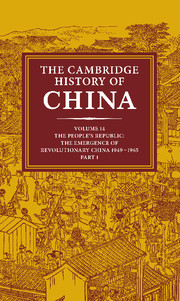Book contents
- Frontmatter
- 1 The reunification of China
- PART 1 EMULATING THE SOVIET MODEL, 1949–1957
- PART II THE SEARCH FOR A CHINESE ROAD, 1958–1965
- 7 The Great Leap Forward and the split in the Yenan leadership
- 8 The Chinese economy under stress, 1958—1965
- 9 New directions in education
- 10 The Party and the intellectuals: phase two
- 11 The Sino-Soviet split
- Bibliographical Essays
- Bibliographical essays for chapters
- Bibliography
- Appendixes: Meetings and Leaders
- Conversion Tables: pinyin and Wade-Giles
- Glossary Index
- Map 1. China’s physical features
- Map 2. PRC: political (Wade–Giles romanization)
- Map 3. PRC: political (pinyin romanization)
- References
7 - The Great Leap Forward and the split in the Yenan leadership
from PART II - THE SEARCH FOR A CHINESE ROAD, 1958–1965
Published online by Cambridge University Press: 28 March 2008
- Frontmatter
- 1 The reunification of China
- PART 1 EMULATING THE SOVIET MODEL, 1949–1957
- PART II THE SEARCH FOR A CHINESE ROAD, 1958–1965
- 7 The Great Leap Forward and the split in the Yenan leadership
- 8 The Chinese economy under stress, 1958—1965
- 9 New directions in education
- 10 The Party and the intellectuals: phase two
- 11 The Sino-Soviet split
- Bibliographical Essays
- Bibliographical essays for chapters
- Bibliography
- Appendixes: Meetings and Leaders
- Conversion Tables: pinyin and Wade-Giles
- Glossary Index
- Map 1. China’s physical features
- Map 2. PRC: political (Wade–Giles romanization)
- Map 3. PRC: political (pinyin romanization)
- References
Summary
AN OVERVIEW
The year 1958 began with the Chinese Communist leaders optimistic about their ability to lead the country up the path of rapid economic development and social progress. To be sure, not all Politburo members agreed on the best methods to use to accomplish these great tasks, but overall confidence was high and the degree of underlying unity clearly sufficient to enable the Chinese Communist Party (CCP) to act in a consistent and decisive manner. Seven years later, deep fissures had rent this leadership to the point where Mao Tsetung himself stood on the verge of launching a devastating attack against many of the colleagues with whom he had worked for more than three decades. That attack would, in turn, launch China into a decade so tumultuous that even in the early 1980s leaders in Peking would look back to the eve of the 1958–65 era wistfully, as the time when the Party's power, prestige, and unity had reached pinnacles. The eight years between 1958 and 1965 were a period of major transition in the Chinese revolution.
To be sure, not all had gone smoothly for the Chinese Communists after 1949. There had been significant disagreement among the leaders over the pace and contours of the development effort. During 1953, for example, Finance Minister Po I-po had come under sharp criticism for advocating tax policies that would, Mao felt, slow down the development of the public sector of the economy. In 1955, Mao openly disagreed with his colleagues over the pace of the proposed collectivization of agriculture and effectively overturned the program they had adopted.
Keywords
- Type
- Chapter
- Information
- The Cambridge History of China , pp. 291 - 359Publisher: Cambridge University PressPrint publication year: 1987
References
- 3
- Cited by

